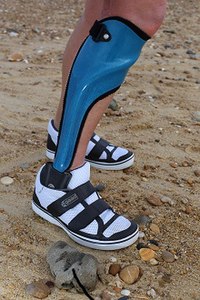
Photo from wikipedia
The first exposure of a rapid displacement of a light touch reference induces an inappropriate balance corrective response during standing in a proportion of participants that is extinguished with repeated… Click to show full abstract
The first exposure of a rapid displacement of a light touch reference induces an inappropriate balance corrective response during standing in a proportion of participants that is extinguished with repeated exposures. We hypothesized that if the spatial touch reference was critical to performing of a task the evoked response would be more consistently expressed across participants and observed with repeated exposures to the disturbance. To test this, 20 participants received either forward (N = 10) or backward right-touch displacements at right-heel strike during motorized treadmill walking without visual feedback. Electromyographic recordings from four arm, four leg and one neck muscle were sampled along with joint kinematic and step cycle data. Rapid displacement of the touch surface elicited responses in all 20 participants. However, the frequency of first trial responses was not different from what was observed during standing. In contrast, responses were observed in all participants with subsequent trials. None of the participants tripped or stumbled as a result of the touch perturbations; however, the step cycle duration was consistently shorter following the first forward-touch displacement. A post-experiment questionnaire revealed that many participants often perceived the touch plate displacement as a disturbance to the treadmill belt speed, suggesting the disturbance was occasionally misinterpreted. The activation of ankle muscles following the unexpected slip of a touch reference during walking suggests that tactile information from the finger is a relevant sensory cue for the regulation and control of stepping and stability.
Journal Title: Experimental Brain Research
Year Published: 2017
Link to full text (if available)
Share on Social Media: Sign Up to like & get
recommendations!